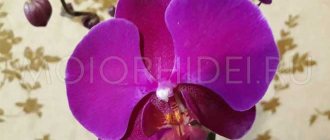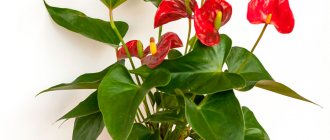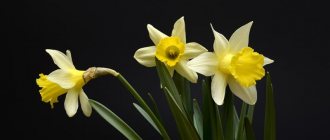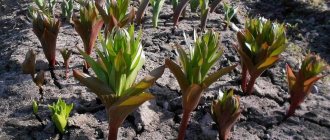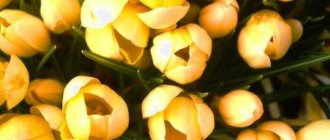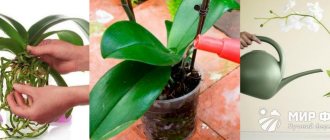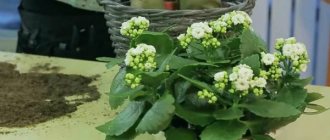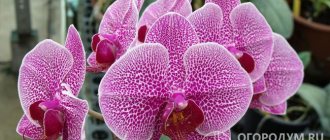Growing petunia in your summer cottage is a fascinating activity. Homemade flowers are always more desirable than purchased or artificial ones. Petunia is not demanding in terms of planting and care, so every gardener can grow a beautiful and healthy flower. One of the popular ways to grow petunias is in pots or flowerpots. They are placed near gazebos and arches and used as elements of landscape design. Caring for flowers consists of watering and fertilizing, pruning and replanting. Let's take a closer look at what it means to care for petunia during flowering in a pot and learn the secrets of experienced flower growers.
Description
Petunia is a herbaceous or subshrub plant from the Solanaceae family. Depending on the species, it grows from 10 cm to 1 m, and the size of the flowers varies from 3 to 16 cm.
Petunia in a container
The plant was first characterized by Lamarck in 1793. He found it in a herbarium from Uruguay.
In 1843, R. Vilmorin united all varieties bred at that time under the general name hybrid petunia (P. x hybrida). This is how varieties of this plant are still called.
Petunia, planting and caring for it is not considered labor-intensive. However, there are varieties that are less resistant to unfavorable conditions. Therefore, when purchasing a flower, it is advisable to familiarize yourself with its care rules.
For reference! The name "petunia" comes from the word Petun, which means "tobacco" in Brazilian.
About the flower
Petunia is a perennial plant belonging to the nightshade family. The height of the plant varies from ten to one hundred centimeters. The flower's homeland is South America, but its main habitat is Brazil. The flower mostly loves warm, temperate climates, although there is one variety that grows in the rather difficult conditions of North America. Today there are about forty species of these plants in the world.
Most of them, since the 18th century, have been grown as decorative balcony and garden plants. Mostly ampelous petunia is grown in pots. Due to the large and fairly bright flowers that have a variety of colors, the plant has become very popular among many gardeners around the world.
The popularity of this plant is so high that an asteroid was named after it, which was discovered in 1921.
Growing from seeds
Indoor petunia - care and cultivation at home
The average development time of this plant from sowing to flowering is 90 days. But you should still be guided by a certain group to which the flower belongs. And also according to the timing of landing on the street.
- So, ampelous varieties are sown in the middle of winter. This allows them to grow long shoots by summer.
- Multifloras are planted in February, late-blooming petunias with large flowers - in March.
- Dwarf varieties are also sown in late winter - early spring, as they bloom quickly.
Important! When sowing, plants are given extra light, as they may not have enough sunlight. Otherwise, the seedlings will stretch out and be frail.
Selection of capacity
Petunia easily tolerates transplantation, so it can be sown directly into containers or seed boxes. The depth of the container should be 6-7 cm.
If the containers have already been used before, they must be cleaned and disinfected before planting. The containers must have a hole to drain excess water.
Preparing soil and seed
The soil for planting seeds should be rich in nutrients, light, neutral. A ready-made mixture for violets, which is sold in garden stores, is suitable. Self-prepared soil includes: turf soil, peat and coarse sand.
A few days before planting, the soil is calcined or poured with boiling water and treated with a solution of potassium permanganate.
Petunia seeds are very small and contain few nutrients. That is why granulated seeds are made for better germination. The disadvantage of such seed material is that its quality is not visible.
Sowing petunia seeds
Planting seeds
For this you will need:
- seeds;
- soil;
- containers for planting;
- scoop, tweezers (the one for lenses is convenient);
- sprayer;
- water;
For the petunia plant, sowing seeds at home begins with placing expanded clay at the bottom of the container. Then a layer of soil, which should be pressed down a little. The substrate is moistened with a spray bottle. Using tweezers, seeds are distributed into containers. The planting material is lightly pressed down; it is sprayed. The top is covered with a glass lid or a plastic bag. Sign the sowing date. It's better not to use a pen - it can wear off over time.
Additional Information. For ease of planting, seeds can be mixed with sand and then simply sown. There is an option for planting on snow, which is poured in a thin, even layer into a container. And the seeds are placed on top. Thus, they are sown evenly over the entire surface and germination promises to be friendly.
After planting, the containers are placed in a room with a temperature of about 24 °C.
How to care for petunia seedlings
Bacopa ampelous - growing and care at home
To obtain strong, healthy petunia seedlings, you need to follow certain rules: hardening, watering, lighting, fertilizing and loosening.
Temperature
To harden seedlings, the temperature is reduced to 20 °C, then to 16 °C. When plants adapt well, night temperatures can be reduced by another 2-3 degrees.
Watering
Petunia requires special care when watering and maintaining air humidity. If you overwater or do not ventilate for a long time, rot may develop and the plant will die. Therefore, water frequently, but with a small amount of water.
You can water from a tray or using a watering can, being careful not to wet the leaves. This procedure should be performed in the morning or evening, when there is no direct sunlight.
Lighting
Petunias are light-loving plants. If after a dive the shoots begin to stretch out or they are pale and frail in appearance, then additional lighting is needed. On a south-facing window, in very bright sun, it is recommended to shade delicate plants.
Growing seedlings
Feeding
The plants are fed for the first time 7-10 days after diving. It is better to apply complex and organic fertilizers. Petunia seedlings are fertilized weekly. To avoid burning it, fertilizers are diluted using half the recommended dose.
Additional Information. When the ground dries out a little, the soil is loosened. This is necessary to ensure better air flow to the roots. Loosening should be done carefully so as not to damage the root system.
When and for how long does the plant bloom?
The flowering period of the plant begins at the end of June and can last until the first cold weather. Flowering of small-flowered varieties begins 70 days after sowing, and large-flowered varieties begin 90-95 days after sowing. Petunia buds take about seven days to develop, each of which can bloom for up to five days.
After the petunia fades, a seed box is formed in place of the inflorescence. If you trim it, you can save the variety for growing petunia next season. It is correct to remove faded flowers immediately , since the plant spends a lot of energy on the development of the seed pod, while the process itself is shortened. You can learn how to properly prune a plant here.
Important! Petunia flowers are very capricious; they can die from excess humidity or drafts. Therefore, it is necessary to monitor timely and sufficient watering, as well as take care of maintaining the desired temperature regime.
Transplantation into open ground
Ampelous petunia - growing in pots and care
Grown petunias are planted outside after all the spring frosts have passed. Transplantation is carried out on a cloudy day so that the seedlings do not get burned.
Step-by-step stages of transplantation:
- Before this, the lump of earth is slightly dried. This will make it easier to remove from the container.
- After the seedling is removed from the container, being careful not to damage the roots, the plant is transferred to the prepared hole.
- Cover with soil and compact the soil around the shoot a little.
- Water the plantings.
The distance between seedlings of large-flowered petunias in the garden is kept at 20-25 cm. Small-flowered ones are planted 15-20 cm apart.
If you need petunia, which will be planted in a container of several pieces, then first they are distributed in the hole. And then the gaps are filled with soil. In this case, it is calculated that there is a liter of soil per root.
After transplanting from home, add a thin layer of peat, last year's humus or sawdust. Thus, preventing the soil from quickly drying out and crusting.
The soil in the open ground is different from the substrate for seedlings. It should be sandy loam soil, heavier, drainage lower than at home.
Most petunias prefer sun or light partial shade, open areas. But when planting young plants in open ground, they should be protected from the scorching sun for some time. For this purpose, use spandex or gauze folded 2-3 times.
Planting petunia in open ground
Attention! Gusts of strong wind and thunderstorms can cause serious damage to the fragile vines of hanging plants. This can negatively affect flowering.
Propagation by cuttings
When propagated by seeds, beautiful hybrids may lose their qualities. For example, a double variety plant will have simple flowers. Also, the color of petunia's petals may change. Therefore, cuttings are used. Terry and hanging petunias are propagated using this method.
For reference! Some varieties of petunias do not produce seeds and, in any case, only cuttings are suitable for them.
For queen cells, young, healthy plants with the flowers you like are selected. If lighting is provided in the apartment and the petunia grows well, then cuttings can be taken throughout the year.
The soil used is the same as for seed propagation. Disinfected coarse sand or vermiculite is poured on top of it in a layer of 2-2.5 cm.
How to plant petunia from cuttings:
- cut off the tops with 4-6 leaves from the mother plant;
- remove the lower leaves, leaving the top 2;
- shorten the remaining leaf blades by half;
- place the cuttings in the ground to ¼ of their length;
- maintain a distance between seedlings - it should be about 2.5 cm;
- cover the container with glass or transparent film;
- put it in the light, not in the scorching sun, and maintain the temperature at 20-25 °C.
Important! Root cuttings immediately after cutting. Otherwise, after an hour, the root formation process may be disrupted.
After planting, the seedlings that begin to take root are sprayed twice a day and ventilated. If there is mold, remove it, increase ventilation and reduce watering. You can spill it with a weak solution of potassium permanganate.
When the roots grow 1.5 cm, the plants can be transplanted into separate pots.
Errors
Petunia leaves often turn yellow. Beginner flower growers face this problem. What to do? This problem does not arise out of nowhere. Yellow leaves on a flower are a sign of excess moisture in the soil, as the roots are rotting. Having noticed problems with the leaves, inspect the petunia. A diseased plant has an inelastic stem. If urgent measures are not taken, it will die. Excess water in the soil causes fungal diseases.
How to proceed?
- If the leaves turn yellow due to excess water, they are removed and the cut areas are treated with fungicides.
- After removing all the affected parts, do not water the petunia for several days. The top layer of soil must dry completely.
- To promote rapid drying of waterlogged soil, loosen it.
Caring for petunias in open ground
You need to know the basic rules of how to care for petunia so that it blooms profusely. To do this, the most important thing is to carry out the following procedures in a timely manner: fertilizing, pinching, pruning.
Petunia pruning
Top dressing
A week after planting the seedlings outside, they begin to fertilize them. First, use a fertilizer with a large amount of nitrogen. This will allow the petunia to grow many vegetative shoots.
After another couple of weeks, complex fertilizer for flowering plants is applied. Potassium predominates in them. It is needed for budding and abundant flowering.
Pinching
By pinching the tops, the bush becomes more voluminous and blooms more friendly. Pinching is carried out several times:
- The first, when the plant has 5-7 leaves.
- The next one is needed when the shoots reach 12-15 cm.
- Then pinch out after 1 - 1.5 weeks, depending on the growth rate of the plant.
Trimming
Caring for petunia during flowering includes pruning the shoots, which stimulates the appearance of new flowers. Also, using this process, the shape and height of the bush are determined. For example, you can create a ball shape or arrange a cascade in a hanging basket.
To ensure petunia is lush and blooming, elongated and faded branches are removed when pruning. If the plant has an unsightly appearance, you can remove half the shoot at once. When shortening the stem, we must not forget about the remaining side branches - they are also trimmed.
Additional Information. Withered flowers and leaves are torn off by hand.
Applying fertilizer to form a strong plant
In order for petunia to form strong and healthy, it is necessary to apply nitrogen fertilizing. A large amount of nitrogen is found in boron, pink crystallon, and plantomome. The use of nitrogen fertilizers allows you to bring the date of flowering of the buds closer, and this fertilizer also promotes the formation of new flowers. Nitrogen fertilizers help to avoid soil depletion, as they provide it with urea, carbyne, potassium humate and magnesium.
In specialized stores, fertilizers are found in granular form. This type is easier to use. After all, plant nutrition begins only when the granules are completely dissolved. And this happens in about 40 minutes. This type of fertilizer is not suitable for petunias, since excess feeding can have a bad effect on the plant. And the amount of fertilizer that will be absorbed into the soil cannot be determined by adding granules. Therefore, it is necessary to use other types of fertilizer.
Before the flowering process of petunia begins, it is necessary to apply fertilizing in larger quantities. Fertilizing should be applied about three times during the whole season. Liquid or dry fertilizer is suitable. Experts say that replenishment of useful microelements should be carried out once every 7 days. This application prevents petunias from withering. You can use Aquarin and Planton S.
Reasons why petunias don't bloom
For lush flowering, it is not enough to plant plants on time. There are a number of reasons why petunias do not bloom, what to do in this case:
- Nutrient imbalance. You should carefully read the instructions for using fertilizers. It’s better to underreport a little than to overdo it with chemicals.
- If the shoots have a poor, dull, thinning appearance, then most likely there is not enough sunlight.
- Improper watering can also cause buds to drop.
Collecting seeds
Petunia seeds are mainly collected from single-colored varieties. If hybrids are propagated in this way, the children may differ from their parents.
Petunia seeds
To properly collect seed material, you need to:
- Bring fruits with seeds into a room where there is light and no draft.
- Open the boxes on paper or a paper towel. Care must be taken to ensure that the seeds do not scatter to the sides. They are very small and can get lost.
- Collect seed material in paper and plastic bags. Eppendorf tubes can be used.
- Sign and put in a dark place to save seeds.
Attention! The seeds are ready for harvesting when the fruit has formed after the flower has withered. It should turn from green to brown. You need to make sure that the box does not have time to open, otherwise the seeds will spill out.
Disease and pest control
Common pests of petunias include aphids, whiteflies, thrips and spider mites. Outdoors it is difficult for them to defeat a healthy plant. Rain, wind, night coolness, ladybugs and birds inhibit their spread.
At home, petunia can die from these pests. To combat them, insecticides are used: Intavir, Konfidor, Aktaru. You can treat with garlic or dandelion infusion. As a preventative measure, maintain air humidity, spray, periodically treat with soap suds (then be sure to rinse off!).
Among the diseases to which petunia flowers are exposed, the most common are black leg, gray rot and powdery mildew. They arise as a result of improper care and weak plant immunity. To avoid this, you need to:
- maintain an interval between seedlings of at least 2-3 cm;
- avoid over-humidification in cold air;
- use neutral soil.
If the plant is sick, treat it with a fungicide. For example, Fitosporin-M, Maxim are suitable.
The result of all of the above
Currently, a large number of varieties of petunias have been bred. This flower is considered a hardy, low-maintenance plant. However, there are varieties that are less resistant to unfavorable conditions. Therefore, when purchasing petunia plant seeds, it is advisable to familiarize yourself with how to plant correctly and when to sow in advance.
Petunia variety Starry Sky
The average development time of this plant from sowing to flowering is 90 days. But you should still be guided by a certain group to which the flower belongs. To obtain strong, healthy petunia seedlings, cultivation and care should include: hardening, watering, lighting, fertilizing and loosening.
Grown petunias are planted outside after all the spring frosts have passed.
When propagated by seeds, hybrids may lose their qualities. Also, the color of petunia's petals may change. Therefore, cuttings are used. Terry and hanging petunias are propagated using this method.
Caring for adult petunias is not difficult, the main thing is to carry out feeding, pinching, and pruning in a timely manner. Petunia seeds are mainly collected from single-colored varieties. If hybrids are propagated in this way, the children may differ from their parents.
Common pests of petunias include aphids, whiteflies, thrips and spider mites. Among the diseases to which petunias are exposed, black leg and gray rot are more common.
General information
Petunia is a surprisingly delicate and cozy flower , the characteristic feature of which is flowers that are shaped like small gramophones, as well as climbing stems, and therefore petunias are often used by gardeners to decorate interior and exterior decoration. The popularity of the plant is also explained by its rich color: from white and soft pink to dark purple. Sometimes bicolor and multicolor species are found.
Petunias are native to the tropical regions of South America, where over thirty species of this amazing plant have already been described. Flowering of petunias begins at the end of June and can last until the end of autumn. Many species, both original and hybrid, are perennials, but, as a rule, gardeners prefer to grow them as annuals because they do not tolerate frost well.
